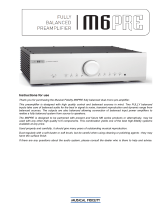
A 3
INSERT
A 4
A 2
A 1
OP2/OP3 STANDBY
PHASE
MUTE
VOL UP
VOL DN
AES
TOS
ST
SPDIF
The Remote Control
The remote provides essentially all the
buttons found on the Wave front panel
plus 2 buttons for Volume. The Wave
front panel has a big knob for volume
and a motor behind it. The remote
uses two buttons to slowly and
smoothly increase or decrease the
volume. No VCAs, no MDACs.
You can see a LED on the remote
blink when you push any of the
buttons and on the Wave front panel
the COMMAND LED also indicates it
has received the command. These are
just "confidence" or "verification"
indicators. You can also watch the
WAVE simply respond to your
commands as every function does
show its status on the front panel.
The Remote Control uses 3 common
AA 1.5 volt batteries. The circuit is
designed to maximise battery life
while providing enough optical power
to control the WAVE from a few
hundred feet. Batteries will probably
last a few years.
There is a way to make the Remote
the "only" control and disable the
Wave front panel button commands if
for example you have kids not allowed
to "play" with the system. One just
puts the remote in a safe place. The
following page shows DIP switch
locations to do this. Changing any of
the DIP switches in the REMOTE will
have the opposite effect. Changing all
3 sets of DIPS is helpful when you
seem to have two remotes that clash.
All functions are labelled the same
and operate the same as on the front
panel. The only possible exception
would be due to a special modification
that changes the function of the
PHASE and OP2/OP3 buttons.
Jumpers inside the Wave can be set
up so that OP2 is toggled by the
PHASE button, which means the only
way to change phase is via the front
panel. When this mod is done, OP2/
OP3 only toggles OP3. This is only
the case if the jumpers are changed
and normally the remote is sent out
with the button labels indicating
exactly what the buttons do.
A Few Notes
There is a few things which don't really fit anywhere else in the manual;
There is no "Empasis" Indicator or LED. The HDCD chip automatically takes care of this in the digital domain
and we chose not to provide a LED for that only because it would almost never glow (so few CDs ever used
that function) and it was always intended to be an invisible, inaudible function.
There is no 88.2, 96 or other sampling rate indicators other than the 32, 44.1 and 48. 88.2 and 44.1 share the
same LED, 96 and 48K share the same LED. Commercial CDs only come in 44.1, so you should see that
LED most of the time. The initial Ultra-Analog DAC board can not deal with those high sample rates.
There is no MONO button. There is also no Phase Reverse function for "just one side only" or the analog
inputs, no DIM button and individual muting of each side. For Mastering engineers and possibly a few
audiophiles this is something we could add as an option and probably not something we could remote control.
We have a maximum of 15 buttons and it is not trivial to mod a 4 layer board.
There are no high voltages on the multi-pin connector until it is mated and the supply is told to turn on. This
makes it particularly safe. However, if it has been on, the mate disconnected and the capacitors have not yet
discharged (it takes about 5 minutes to discharge connected and 15 minutes disconnected) then if somebody
were to touch those pins, they might get a 300VDC shock - non lethal, but very startling and possibly giving
pin-prick burns. Not something for children to play with. The household AC sockets are far more dangerous.
Poking wires, pins etc through the cooling slots is also a bad idea with any electrical/electronic gear.
11






















